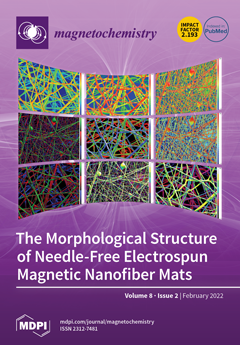It is well recognized that intermetallics based on rare-earth (R) and transition metals (T) display numerous interesting magnetic properties, leading to potential applications in different fields. The latest progress regarding magnetic properties and the magnetocaloric effect (MCE) in the nanostructured Pr
Co
compound, as well as its carbides and hydrides, is reviewed in this paper. Some of this progress reveals remarkable MCE performance, which makes it attractive in the field of magnetic refrigeration at high temperatures. With the purpose of understanding the magnetic and magnetocaloric characteristics of these compounds, the crystal structure, microstructure, and magnetism are also brought into focus. The Pr
Co
compound has interesting magnetic properties, such as a high Curie temperature T
and uniaxial magnetocrystalline anisotropy. It crystallizes in a hexagonal structure (2:7 H) of the Ce
Ni
type and is stable at relatively low temperatures (T
≤ 1023 K), or it has a rhombohedral structure (2:7 R) of the Gd
Co
type and is stable at high temperatures (T
≥ 1223 K). Studies of the magnetocaloric properties of the nanocrystalline Pr
Co
compound have shown the existence of a large reversible magnetic entropy change (
S
) with a second-order magnetic transition. After its substitution, we showed that nanocrystalline Pr
Co
Fe
compounds that were annealed at T
= 973 K crystallized in the 2:7 H structure similarly to the parent compound. The extended X-ray absorption fine-structure (EXAFS) spectra adjustments showed that Fe atoms preferably occupy the 12k site for x ≤ 1. The study of the magnetic properties of nanocrystalline Pr
Co
Fe
compounds revealed an increase in T
of about 26% for x = 0.5, as well as an improvement in the coercivity, H
(12 kOe), and the (BH)
(9 MGOe) product. On the other hand, the insertion of C atoms into the Pr
Co
cell led to a marked improvement in the T
value of 21.6%. The best magnetic properties were found for the Pr
Co
C
compound annealed at 973 K, H
= 10.3 kOe, and (BH)
= 11.5 MGOe. We studied the microstructure, hydrogenation, and magnetic properties of nanocrystalline Pr
Co
H
hydrides. The crystal structure of the Pr
Co
compound transformed from a hexagonal (P6
3/mmc) into an orthorhombic (Pbcn) and monoclinic (C2/c) structure during hydrogenation. The absorption of H by the Pr
Co
compound led to an increase in the T
value from 600 K at x = 0 to 691 K at x = 3.75. The Pr
Co
H
hydride had optimal magnetic properties: H
= 6.1 KOe, (BH)
= 5.8 MGOe, and T
= 607 K. We tailored the mean field theory (MFT) and random magnetic anisotropy (RMA) methods to investigate the magnetic moments, exchange interactions, and magnetic anisotropy properties. The relationship between the microstructure and magnetic properties is discussed. The obtained results provide a fundamental reference for adapting the magnetic properties of the Pr
Co
, Pr
Co
Fe
, Pr
Co
C
, and Pr
Co
H
compounds for potential permanent nanomagnets, high-density magnetic recording, and magnetic refrigeration applications.
Full article





